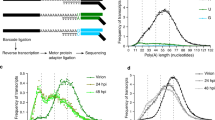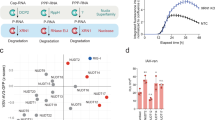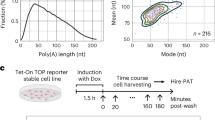Abstract
Many orthopoxvirus messenger RNAs have an unusual nontemplated poly(A) tract of 5 to 40 residues at the 5′ end. The precise function of this feature is unknown. Here we show that 5′ poly(A) tracts are able to repress RNA decay by inhibiting 3′-to-5′ exonucleases as well as decapping of RNA substrates. UV cross-linking analysis demonstrated that the Lsm complex associates with the 5′ poly(A) tract. Furthermore, recombinant Lsm1–7 complex specifically binds 5′ poly(A) tracts 10 to 21 nucleotides in length, consistent with the length of 5′ poly(A) required for stabilization. Knockdown of Lsm1 abrogates RNA stabilization by the 5′ poly(A) tract. We propose that the Lsm complex simultaneously binds the 3′ and 5′ ends of these unusual messenger RNAs and thereby prevents 3′-to-5′ decay. The implications of this phenomenon for cellular mRNA decay are discussed.
This is a preview of subscription content, access via your institution
Access options
Subscribe to this journal
Receive 12 print issues and online access
$189.00 per year
only $15.75 per issue
Buy this article
- Purchase on Springer Link
- Instant access to full article PDF
Prices may be subject to local taxes which are calculated during checkout







Similar content being viewed by others
References
Edmonds, M. A history of poly A sequences: from formation to factors to function. Prog. Nucleic Acid Res. Mol. Biol. 71, 285–389 (2002).
Zhao, J., Hyman, L. & Moore, C. Formation of mRNA 3′ ends in eukaryotes: mechanism, regulation, and interrelationships with other steps in mRNA synthesis. Microbiol. Mol. Biol. Rev. 63, 405–445 (1999).
Coller, J.M., Gray, N.K. & Wickens, M.P. mRNA stabilization by poly(A) binding protein is independent of poly(A) and requires translation. Genes Dev. 12, 3226–3235 (1998).
Gray, N.K., Coller, J.M., Dickson, K.S. & Wickens, M. Multiple portions of poly(A)-binding protein stimulate translation in vivo. EMBO J. 19, 4723–4733 (2000).
Wells, S.E., Hillner, P.E., Vale, R.D. & Sachs, A.B. Circularization of mRNA by eukaryotic translation initiation factors. Mol. Cell 2, 135–140 (1998).
Shyu, A.B., Belasco, J.G. & Greenberg, M.E. Two distinct destabilizing elements in the c-fos message trigger deadenylation as a first step in rapid mRNA decay. Genes Dev. 5, 221–231 (1991).
Decker, C.J. & Parker, R. A turnover pathway for both stable and unstable mRNAs in yeast: evidence for a requirement for deadenylation. Genes Dev. 7, 1632–1643 (1993).
Tharun, S., Muhlrad, D., Chowdhury, A. & Parker, R. Mutations in the Saccharomyces cerevisiae LSM1 gene that affect mRNA decapping and 3′ end protection. Genetics 170, 33–46 (2005).
Tharun, S. & Parker, R. Targeting an mRNA for decapping: displacement of translation factors and association of the Lsm1p-7p complex on deadenylated yeast mRNAs. Mol. Cell 8, 1075–1083 (2001).
He, W. & Parker, R. The yeast cytoplasmic LsmI/Pat1p complex protects mRNA 3′ termini from partial degradation. Genetics 158, 1445–1455 (2001).
Hsu, C.L. & Stevens, A. Yeast cells lacking 5′ → 3′ exoribonuclease 1 contain mRNA species that are poly(A) deficient and partially lack the 5′ cap structure. Mol. Cell. Biol. 13, 4826–4835 (1993).
Mukherjee, D. et al. The mammalian exosome mediates the efficient degradation of mRNAs that contain AU-rich elements. EMBO J. 21, 165–174 (2002).
Raijmakers, R., Schilders, G. & Pruijn, G.J. The exosome, a molecular machine for controlled RNA degradation in both nucleus and cytoplasm. Eur. J. Cell Biol. 83, 175–183 (2004).
Liu, H., Rodgers, N.D., Jiao, X. & Kiledjian, M. The scavenger mRNA decapping enzyme DcpS is a member of the HIT family of pyrophosphatases. EMBO J. 21, 4699–4708 (2002).
Swaminathan, S. Post-transcriptional gene regulation by gamma herpesviruses. J. Cell. Biochem. 95, 698–711 (2005).
Rice, A.P. & Roberts, B.E. Vaccinia virus induces cellular mRNA degradation. J. Virol. 47, 529–539 (1983).
Ahn, B.Y. & Moss, B. Capped poly(A) leaders of variable lengths at the 5′ ends of vaccinia virus late mRNAs. J. Virol. 63, 226–232 (1989).
Patel, D.D. & Pickup, D.J. Messenger RNAs of a strongly-expressed late gene of cowpox virus contain 5′-terminal poly(A) sequences. EMBO J. 6, 3787–3794 (1987).
Schwer, B., Visca, P., Vos, J.C. & Stunnenberg, H.G. Discontinuous transcription or RNA processing of vaccinia virus late messengers results in a 5′ poly(A) leader. Cell 50, 163–169 (1987).
Ink, B.S. & Pickup, D.J. Vaccinia virus directs the synthesis of early mRNAs containing 5′ poly(A) sequences. Proc. Natl. Acad. Sci. USA 87, 1536–1540 (1990).
Baldick, C.J., Jr & Moss, B. Characterization and temporal regulation of mRNAs encoded by vaccinia virus intermediate-stage genes. J. Virol. 67, 3515–3527 (1993).
Ahn, B.Y., Jones, E.V. & Moss, B. Identification of the vaccinia virus gene encoding an 18-kilodalton subunit of RNA polymerase and demonstration of a 5′ poly(A) leader on its early transcript. J. Virol. 64, 3019–3024 (1990).
de Magistris, L. & Stunnenberg, H.G. Cis-acting sequences affecting the length of the poly(A) head of vaccinia virus late transcripts. Nucleic Acids Res. 16, 3141–3156 (1988).
Bergman, N., Opyrchal, M., Bates, E.J. & Wilusz, J. Analysis of the products of mRNA decapping and 3′-to-5′ decay by denaturing gel electrophoresis. RNA 8, 959–965 (2002).
Gorlach, M., Burd, C.G. & Dreyfuss, G. The mRNA poly(A)-binding protein: localization, abundance, and RNA-binding specificity. Exp. Cell Res. 211, 400–407 (1994).
Eystathioy, T. et al. The GW182 protein colocalizes with mRNA degradation associated proteins hDcp1 and hLSm4 in cytoplasmic GW bodies. RNA 9, 1171–1173 (2003).
Zaric, B. et al. Reconstitution of two recombinant LSm protein complexes reveals aspects of their architecture, assembly, and function. J. Biol. Chem. 280, 16066–16075 (2005).
Mayes, A.E., Verdone, L., Legrain, P. & Beggs, J.D. Characterization of Sm-like proteins in yeast and their association with U6 snRNA. EMBO J. 18, 4321–4331 (1999).
Achsel, T. et al. A doughnut-shaped heteromer of human Sm-like proteins binds to the 3′-end of U6 snRNA, thereby facilitating U4/U6 duplex formation in vitro. EMBO J. 18, 5789–5802 (1999).
Mikulecky, P.J. et al. Escherichia coli Hfq has distinct interaction surfaces for DsrA, rpoS and poly(A) RNAs. Nat. Struct. Mol. Biol. 11, 1206–1214 (2004).
Sun, X. & Wartell, R.M. Escherichia coli Hfq binds A18 and DsrA domain II with similar 2:1 Hfq6/RNA stoichiometry using different surface sites. Biochemistry 45, 4875–4887 (2006).
Wilusz, C.J. & Wilusz, J. Eukaryotic Lsm proteins: lessons from bacteria. Nat. Struct. Mol. Biol. 12, 1031–1036 (2005).
Folichon, M. et al. The poly(A) binding protein Hfq protects RNA from RNase E and exoribonucleolytic degradation. Nucleic Acids Res. 31, 7302–7310 (2003).
Mohanty, B.K., Maples, V.F. & Kushner, S.R. The Sm-like protein Hfq regulates polyadenylation dependent mRNA decay in Escherichia coli. Mol. Microbiol. 54, 905–920 (2004).
Vytvytska, O., Moll, I., Kaberdin, V.R., von Gabain, A. & Bläsi, U. Hfq (HF1) stimulates ompA mRNA decay by interfering with ribosome binding. Genes Dev. 14, 1109–1118 (2000).
Kufel, J., Bousquet-Antonelli, C., Beggs, J.D. & Tollervey, D. Nuclear pre-mRNA decapping and 5′ degradation in yeast require the Lsm2–8p complex. Mol. Cell. Biol. 24, 9646–9657 (2004).
Lee-Chen, G.J. & Niles, E.G. Transcription and translation mapping of the 13 genes in the vaccinia virus HindIII D fragment. Virology 163, 52–63 (1988).
Parrish, S. & Moss, B. Characterization of a vaccinia virus mutant with a deletion of the D10R gene encoding a putative negative regulator of gene expression. J. Virol. 80, 553–561 (2006).
Parrish, S., Resch, W. & Moss, B. Vaccinia virus D10 protein has mRNA decapping activity, providing a mechanism for control of host and viral gene expression. Proc. Natl. Acad. Sci. USA 104, 2139–2144 (2007).
Patel, G.P., Ma, S. & Bag, J. The autoregulatory translational control element of poly(A)-binding protein mRNA forms a heteromeric ribonucleoprotein complex. Nucleic Acids Res. 33, 7074–7089 (2005).
Dorokhov, Y.L. et al. Polypurine (A)-rich sequences promote cross-kingdom conservation of internal ribosome entry. Proc. Natl. Acad. Sci. USA 99, 5301–5306 (2002).
Ford, L.P., Watson, J., Keene, J.D. & Wilusz, J. ELAV proteins stabilize deadenylated intermediates in a novel in vitro mRNA deadenylation/degradation system. Genes Dev. 13, 188–201 (1999).
Wilusz, J. & Shenk, T. A 64 kd nuclear protein binds to RNA segments that include the AAUAAA polyadenylation motif. Cell 52, 221–228 (1988).
Ford, L.P. & Wilusz, J. An in vitro system using HeLa cytoplasmic extracts that reproduces regulated mRNA stability. Methods 17, 21–27 (1999).
Acknowledgements
This work was supported by a grant from the US National Institutes of Health (GM72481) to J.W. B.Z. contributed to the paper while receiving Swiss National Foundation funds in the laboratory of C.K. We thank E.K.L. Chan (University of Florida) for supplying the Lsm4-specific antibodies, K. Sokoloski (Colorado State University) for the sequence of hamster Lsm1 and D. Pickup (Duke University) for helpful discussions.
Author information
Authors and Affiliations
Contributions
K.C.M.M. and N.B. performed most of the experiments and contributed to their analysis and design. N.B. initially discovered the novel role and properties of the Lsm complex, and also constructed the Lsm1-knockdown cells together with R.J.S. B.Z. and C.K. purified and reconstituted the Lsm complexes. C.J.W. wrote a large portion of the paper and contributed to experimental design and analysis. J.W. was conceived the project, was involved in design and analysis of experiments, and performed some of the electroporation studies with assistance from J.R.A.
Corresponding author
Ethics declarations
Competing interests
The authors declare no competing financial interests.
Rights and permissions
About this article
Cite this article
Bergman, N., Moraes, K., Anderson, J. et al. Lsm proteins bind and stabilize RNAs containing 5′ poly(A) tracts. Nat Struct Mol Biol 14, 824–831 (2007). https://doi.org/10.1038/nsmb1287
Received:
Accepted:
Published:
Issue Date:
DOI: https://doi.org/10.1038/nsmb1287
This article is cited by
-
5′ capped and 3′ polyA-tailed sgRNAs enhance the efficiency of CRISPR-Cas9 system
Protein & Cell (2019)
-
Lsm2 and Lsm3 bridge the interaction of the Lsm1-7 complex with Pat1 for decapping activation
Cell Research (2014)
-
mRNA-based therapeutics — developing a new class of drugs
Nature Reviews Drug Discovery (2014)
-
Spinal muscular atrophy: why do low levels of survival motor neuron protein make motor neurons sick?
Nature Reviews Neuroscience (2009)



